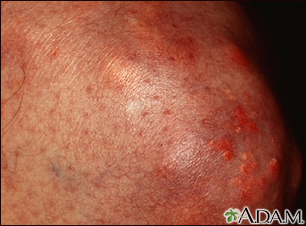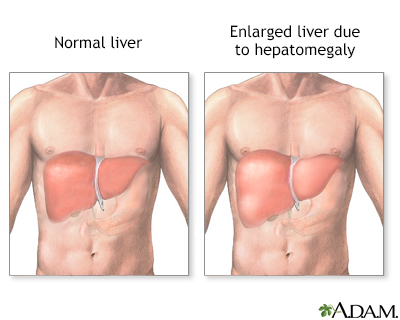Chylomicronemia syndrome
Chylomicronemia syndrome is a disorder in which the body does not break down fats (lipids) correctly. This causes fat particles called chylomicrons to build up in the blood. The disorder is passed down through families.
Causes
Chylomicronemia syndrome can occur due to a rare genetic disorder in which a protein (enzyme) called lipoprotein lipase (LpL) is broken or missing. It can also be caused by the absence of second factor called apo C-II, which activates LpL. LpL is normally found in fat and muscle. It helps break down certain lipids. When LpL is missing or broken, fat particles called chylomicrons build up in the blood. This buildup is called chylomicronemia.
Defects in apolipoprotein CII and apolipoprotein AV can cause the syndrome as well. It is more likely to occur when people who are predisposed to have high triglycerides (such as those who have familial combined hyperlipidemia or familial hypertriglyceridemia) develop diabetes, obesity or are exposed to certain medicines.
Familial combined hyperlipidemia
Familial combined hyperlipidemia is a disorder that is passed down through families. It causes high cholesterol and high blood triglycerides....

Familial hypertriglyceridemia
Familial hypertriglyceridemia is a common disorder passed down through families. It causes a higher-than-normal level of triglycerides (a type of fa...

Symptoms
Symptoms may start in infancy and include:
- Abdominal pain due to pancreatitis (inflammation of the pancreas).
- Symptoms of nerve damage, such as loss of feeling in the feet or legs, and memory loss.
- Yellow deposits of fatty material in the skin called xanthomas. These growths may appear on the back, buttocks, soles of the feet, or ankles, knees and elbows.
Exams and Tests
A physical exam and tests may show:
-
Enlarged liver and spleen
Enlarged liver
Enlarged liver refers to swelling of the liver beyond its normal size. Hepatomegaly is another word to describe this problem. If both the liver and ...
 ImageRead Article Now Book Mark Article
ImageRead Article Now Book Mark Article - Inflammation of the pancreas
- Fatty deposits under the skin
- Possibly fatty deposits in the retina of the eye
Retina
The retina is the light-sensitive layer of tissue at the back of the eyeball. Images that come through the eye's lens are focused on the retina. Th...
 ImageRead Article Now Book Mark Article
ImageRead Article Now Book Mark Article
A creamy layer will appear when blood spins in a laboratory machine. This layer is due to chylomicrons in the blood.
The triglyceride level is extremely high.
Triglyceride level
The triglyceride level is a blood test to measure the amount of triglycerides in your blood. Triglycerides are a type of fat. Your body makes some t...

Treatment
A fat-free, alcohol-free diet is required. You may need to stop taking certain medicines that can make symptoms worse. Do not stop taking any medicine without first talking to your health care provider. Conditions such as dehydration and diabetes can make symptoms worse. If diagnosed, these conditions need to be treated and controlled.
Outlook (Prognosis)
A fat-free diet can reduce symptoms dramatically.
Possible Complications
When untreated, the excess chylomicrons may lead to bouts of pancreatitis. This condition can be very painful and even life threatening.
When to Contact a Medical Professional
Seek medical care right away if you have abdominal pain or other warning signs of pancreatitis.
Contact your provider if you have a personal or family history of high triglyceride levels.
Prevention
There is no way to prevent someone from inheriting this syndrome.
Reviewed By
Michael A. Chen, MD, PhD, Associate Professor of Medicine, Division of Cardiology, Harborview Medical Center, University of Washington Medical School, Seattle, WA. Also reviewed by David C. Dugdale, MD, Medical Director, Brenda Conaway, Editorial Director, and the A.D.A.M. Editorial team.
Genest J, Mora S, Libby P. Lipoprotein disorders and cardiovascular disease. In: Libby P, Bonow RO, Mann DL, Tomaselli GF, Bhatt DL, Solomon SD, eds. Braunwald's Heart Disease: A Textbook of Cardiovascular Medicine. 12th ed. Philadelphia, PA: Elsevier; 2022:chap 27.
Robinson JG. Disorders of lipid metabolism. In: Goldman L, Schafer AI, eds. Goldman-Cecil Medicine. 26th ed. Philadelphia, PA: Elsevier; 2020:chap 195.
Disclaimer



 All rights reserved.
All rights reserved.